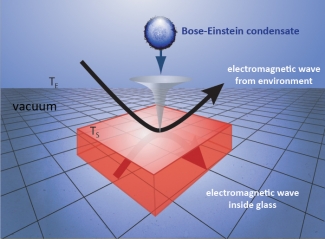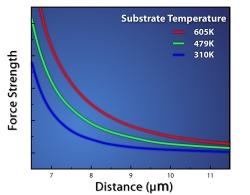Small changes in the quantum fluctuations of free space are responsible for a variety of curious phenomena: a gecko’s ability to walk across ceilings, the evaporation of black holes via Hawking radiation, and the fact that warmer surfaces can be stickier than cold ones in micro- and nanoscale electromechanical systems (MEMS and NEMS). The tendency of tiny parts to stick together is a consequence of the Casimir force.
A related attractive force, called the Casimir-Polder force, occurs between an atom and a surface. The temperature dependence of this force was recently measured for the first time by graduate students John Obrecht and Robert Wild and Fellow Eric Cornell. Colleagues from the Università di Trento in Italy contributed theoretical calculations to their efforts.
To measure the temperature dependence of the force between an atom and a surface, the researchers positioned a Bose-Einstein condensate (BEC) of 250,000 rubidium atoms (in a magnetic trap) a few microns from a glass plate. As they moved the BEC closer to the plate, they were able to measure changes in the frequency of normal oscillations of the BEC and calculate the Casimir-Polder force. Doubling the temperature of the plate from 310 to 605 K resulted in a threefold increase in the force.




 The Physics Frontiers Centers (PFC) program supports university-based centers and institutes where the collective efforts of a larger group of individuals can enable transformational advances in the most promising research areas. The program is designed to foster major breakthroughs at the intellectual frontiers of physics by providing needed resources such as combinations of talents, skills, disciplines, and/or specialized infrastructure, not usually available to individual investigators or small groups, in an environment in which the collective efforts of the larger group can be shown to be seminal to promoting significant progress in the science and the education of students. PFCs also include creative, substantive activities aimed at enhancing education, broadening participation of traditionally underrepresented groups, and outreach to the scientific community and general public.
The Physics Frontiers Centers (PFC) program supports university-based centers and institutes where the collective efforts of a larger group of individuals can enable transformational advances in the most promising research areas. The program is designed to foster major breakthroughs at the intellectual frontiers of physics by providing needed resources such as combinations of talents, skills, disciplines, and/or specialized infrastructure, not usually available to individual investigators or small groups, in an environment in which the collective efforts of the larger group can be shown to be seminal to promoting significant progress in the science and the education of students. PFCs also include creative, substantive activities aimed at enhancing education, broadening participation of traditionally underrepresented groups, and outreach to the scientific community and general public.